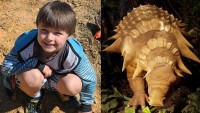Tail Feather of Dinosaur Found in Amber Further Proof Birds Descended from Dinosaurs
| Arthur Dominic Villasanta | | Dec 09, 2016 07:43 AM EST |
(Photo : Royal Saskatchewan Museum ) Baby dinosaur's tail feather encased in amber.
The 99 million year-old tail feather of a small dinosaur encased in amber found in a market in Myanmar by a Chinese scientist is one of the best proofs yet that dinosaurs did indeed have feathers.
The tiny bit of amber the size of an eraser bought in 2015 by Lida Xing, a paleontologist at China University of Geosciences in Beijing, was believed by the people who dug it out of a mine to be a kind of plant and were trying to sell it to be made into jewelry.
Like Us on Facebook
Xing, however, realized what it really was -- the tip of a preserved dinosaur tail section - after a closer look. Further examination using sophisticated scanning and microscopic equipment confirmed the 36 mm long feather complete with bones, flesh, and skin encased in amber did indeed come from a dinosaur.
The tail consisted of eight vertebrae, soft tissue and feathers preserved in three dimensions.
Scientists believe the tail belonged to a type of two-legged, bird-like dinosaur called a "maniraptoran," a type of feathered coelurosaurian dinosaur that includes birds and non-avian dinosaurs. Coelurosaurian dinosaurs are closely related to the Tyrannosaurus rex and Velociraptor.
Birds, which first appeared about 150 million years ago during the Jurassic Period, evolved from small, feathered dinosaurs such as this one.
"I have studied paleontology for more than 10 years and have been interested in dinosaurs for more than 30 years," said Xing.
"But I never expected we could find a dinosaur in amber. This may be the coolest find in my life. The feathers on the tail are so dense and regular. This is really wonderful."
Scientists have named the baby coelurosaur from which the feather came from as "Eva." Scientists say Eva was so small she could stand on the palm of your hand.
"This is the first of its kind," said paleontologist Ryan McKellar of the Royal Saskatchewan Museum in Canada, one of the researchers involved in the study published in the journal Current Biology. "I'm blown away."
"It's a spectacular little glimpse," McKellar says. "It gives us, basically, a pathway that gets us to modern feathers."
Tagsdinosaur, feathers, maniraptoran, Coelurosaurian dinosaurs, Lida Xing, China University of Geosciences, Ryan McKellar, Royal Saskatchewan Museum
©2015 Chinatopix All rights reserved. Do not reproduce without permission
 World's Largest Dinosaur Footprint Unearthed in the Gobi Desert
World's Largest Dinosaur Footprint Unearthed in the Gobi Desert Scientists Stumble upon Dinosaur Fossils in Antarctica
Scientists Stumble upon Dinosaur Fossils in Antarctica Killer Asteroid that Destroyed the Dinosaurs Led to the Rise of the Human Race
Killer Asteroid that Destroyed the Dinosaurs Led to the Rise of the Human Race 4 Year-old Texas Boy Discovers 100 Million Year-old Dinosaur Fossil
4 Year-old Texas Boy Discovers 100 Million Year-old Dinosaur Fossil Largest Dinosaur in History Found in Argentina
Largest Dinosaur in History Found in Argentina
EDITOR'S PICKS
-

Did the Trump administration just announce plans for a trade war with ‘hostile’ China and Russia?
-

US Senate passes Taiwan travel bill slammed by China
-

As Yan Sihong’s family grieves, here are other Chinese students who went missing abroad. Some have never been found
-

Beijing blasts Western critics who ‘smear China’ with the term sharp power
-

China Envoy Seeks to Defuse Tensions With U.S. as a Trade War Brews
-

Singapore's Deputy PM Provides Bitcoin Vote of Confidence Amid China's Blanket Bans
-

China warns investors over risks in overseas virtual currency trading
-

Chinese government most trustworthy: survey
-

Kashima Antlers On Course For Back-To-Back Titles
MOST POPULAR
LATEST NEWS
Zhou Yongkang: China's Former Security Chief Sentenced to Life in Prison

China's former Chief of the Ministry of Public Security, Zhou Yongkang, has been given a life sentence after he was found guilty of abusing his office, bribery and deliberately ... Full Article
TRENDING STORY

China Pork Prices Expected to Stabilize As The Supplies Recover

Elephone P9000 Smartphone is now on Sale on Amazon India

There's a Big Chance Cliffhangers Won't Still Be Resolved When Grey's Anatomy Season 13 Returns

Supreme Court Ruled on Samsung vs Apple Dispute for Patent Infringement

Microsoft Surface Pro 5 Rumors and Release Date: What is the Latest?










